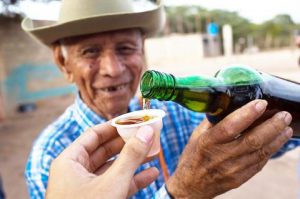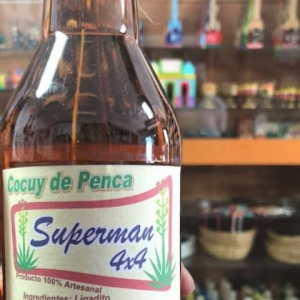In the bar industry Venezuela is best known for its superb rum, but there is a traditional spirit that is seeing a resurgence.
Since Venezuela’s controversial president/dictator Hugo Chávez died in 2013, the country, under the reigns of Chávez’s right-hand man Nicolás Maduro and burdened with many of the problems left by Chávez, has collapsed into financial turmoil. Basic supplies have been in short supply and prices of many items have skyrocketed, as a result more than 5 million people have left the country.

We aren’t going to go into great detail about the problems the country is facing but it is important to understand the financial plight of its population to understand the resurgence of its traditional spirit Cocuy (pronounced ko:kujj or a k noise followed by koi (as in the fish)). According to an NPR article whisk(e)y (in 2014 Venezuela was the second biggest consumer of whisk(e)y per capita in Latin America) and even beer have become prohibitively expensive for most people. Rum prices haven’t been hit as hard but is still mainly a drink for those households with a higher than average income.
To put it into context a case of beer now cost around $20 whereas a litre of Cocuy costs just $2 (even less if you bring your bottle back for a refill). As you can imagine Cocuy sales are exploding in Venezuela and whilst it isn’t yet available in the UK there are a few reasons we think it could well be finding its way onto your back bar in the near future.
What is Cocuy?
It is often referred to as ‘Venezuelan Tequila’ which I would imagine pisses off Cocuy producers no-end, but as a quick explanation it makes sense (although ‘Venezuelan Mezcal’ would probably be more accurate). Cocuy is made from a green Agave variety called Agave cucoi which is mainly grown in the 2 of Venezuela’s 23 states, those of Lara and Falcón in the North West of the country.
The production of Cocuy will sound pretty familiar to anyone with knowledge of Mezcal. The Agave cucoi is harvested when ripe (usually between 7 – 10 years) and the head/pineapple are baked in pits dug into the ground often with river stones on the base and sides, it is then covered with the leaves of the plant and heated with burning wood. After being in the ground for 3-4 days the agave is removed and macerated in a wooden bucket before being pressed. Brown sugar is added to the juices and this is fermented in open top vats made of metal or wood before being distilled. Some of the Cocuy’s available are then aged in wooden barrels before bottling.
Venezuela has three protected Designation of Origins covering food and drink. The first is for Cacao Chuao, a very delicious sounding chocolate, the second is for Ron de Venezuela, for rum brands which meet certain quality and origin requirements such as Diplomatico, Santa Teresa and Pampero.
The third is for Cocuy Pecayero, a Cocuy produced in the Pecaya Parish of Falcón. The soil and weather in this region are particularly good for growing Agave cucoi with minimum night temperatures of 26 degrees and maximum day temperatures of 42 degrees. All this leads to the sugars of the plant being perfect for production.
The latest list of brands with this Designation of Origin we can find consists of Indio Sunure, Casa Vieja, Caja de Agua, Los Dátires, Ángel Divino, Santa Lucía, Mi Empeño and Lucerito de Pecaya. This isn’t to say Cocuy produced from outside this region are not as good, these are just the ones easily recognisable as they have the stamp.
With the recent increase in popularity flavoured Cocuy has also seen a surge in demand with flavours such as peach, pineapple and ginger. One of the more unusual and popular variations is called ‘blind snake’ which is sold with a dead snake in the bottle, it is considered to have medicinal qualities.
The History of Cucoy
Much like its cousins in Mexico, Agave cucoi has been part of the culture of the country long before explorers discovered the place even existed. The aboriginal tribes of Aymanes, Xaguas and Jiraharas used the cucoi plant for raw material and food. They may well have made a non-alcoholic drink from the plant as well, much like pulque in Mexico.

The Spanish invaded in 1502 and started to settle the country (or fuck it up depending on your view of history). Eventually the Spanish brought over their distillation skills and discovered the joys of the Agave cocui. There is no exact date that we could find for the production starting but with the Spanish making mezcal in Mexico around this time it seems logical to assume Cucoy was being produced pretty soon after they arrived.
It was made in very traditional ways for centuries after this and consumed with great gusto by Venezuelans. Over time rum and then whisk(e)y became more popular but not without some help by the Venezuelan government.
In the 1930’s and 40’s Cocuy was beginning to be exported but this all came to a crashing halt in 1954 when the government outlawed the making and selling of Cocuy. Whilst many reasons have been given and suggested the simple fact appears to be, as it often is, money. Making Cocuy was mainly an artisan pastime and often made in small amounts which meant it was very difficult to tax those making it for friends, family and locals.
Rum and beer however were, on the whole, much larger operations and the government was making plenty of tax from them as they were from imports such as Brandy and Whisk(e)y. So to ensure they made the most money possible they stopped people from being allowed to drink Cocuy, the Venezuelan government doesn’t cover its self in glory historiacally it must be said.
There was one exception ‘aguardiente de cocuy’ (roughly translated as cocuy spirits), which was a combination of neutral alcohol and cocuy but this was heavily regulated (and therefore taxed) by the government not least because they had control of neutral spirit production and importation.
Thankfully in 2005 the law was reversed and ratified in 2007 allowing 100% agave cocui Cocuy to be produced again. This allowed the artisan producers to once again legally produce their Cocuy (we aren’t saying any of them were illegally producing before this but……) alongside the industrial producers who flourished with Aguardiente de Cocuy.
That is the full circle back to where this article started with a country in turmoil and Cocuy rising to prominence once again.
Why could it be coming over here?
Earlier we said there were a few reasons we suspect Cocuy could be coming to bars across the UK so let’s look at them.
Similarity to Tequila and Mezcal – Over recent years we have seen consumers, thanks to some tireless work from many educators, not least our recently departed friend Tomas Estes and son Jesse, warm to the joys of tequila as a quality and delicious product not just a shitty shot. Whilst Mezcal may still be much more of a bartender product it is appearing on more and more cocktail menus as we understand how best to use it.
Love of Venezuelan products – As previously touched on the rums of Venezuela have long been loved by bartenders and consumers the world over. Not only does that help open the doors to another of the countries spirits but it also importantly means there is the infostructure in place in the country already to export globally.
History – Whilst it has a long and rich history it was kneecapped as a product to be enjoyed outside of Venezuela by the government just as it was beginning to get going. Unlike other spirits that have never quite made the jump from holiday favourite to cocktail list staple (Cachaca automatically coming to mind) Cocuy hasn’t yet had the chance to spread its wings.
Bartenders – Come on. It’s made in pits, no-one has heard of it and its artisanal. That’s the bartender trifecta. You’re bound to love it.
So is Cocuy going to be the next medium sized thing in the UK bar industry? Possibly. Who knows how trends go but if nothing else I bet reading this has got you wanting to try some hasn’t it? Bad luck, there is currently none commercially available in the UK (or Europe as far as we can tell), but if we all start talking about it you can bet someone will see an opportunity and get it over here.
Thanks to Jim Wrigley for sharing the NPR article on Facebook which started us down this rabbit hole of Spanish articles and google translate. We’ll be bringing you the lowdown on another unfamiliar spirit soon.


